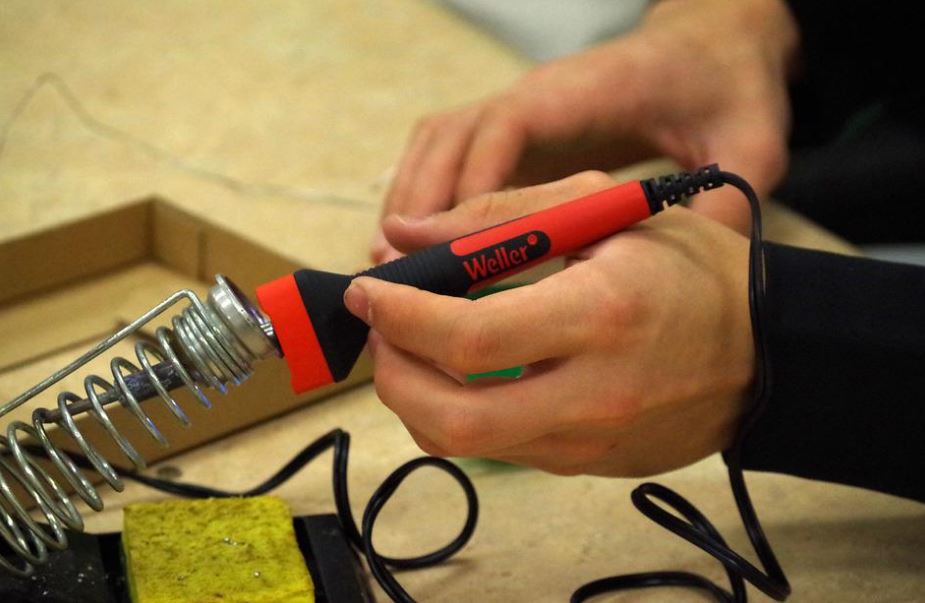You’ve heard about soldering irons and soldering guns. You think to yourself, what’s the difference between them? After all, they both do soldering related activities.
But here’s a surprising fact for you. Although they are used for soldering purposes, both of them have significant differences.

Also, if you haven’t taken up much soldering work, then you may be in a confused state of mind on which soldering equipment to go for. Either way, you are in the right place.
In this guide, we’ll have a detailed discussion about what is a soldering gun and a soldering iron, the differences between a soldering gun vs soldering iron, general FAQs about these soldering equipments and much more.
After reading this guide, we are confident that you wouldn’t be disappointed.
So without much delay, let’s get started!
What is a Soldering Gun?
You can think of soldering gun as a pistol. In fact, it operates much like that. This soldering equipment is electrically powered.
It uses a tin-based solder to join various metal surfaces. A soldering gun operates with a really good electrical contact and hence, the joints are pretty strong. It exactly resembles a gun and trigger is used for easy operation of the equipment. Soldering guns are much more effective as they don’t require frequent breaks like soldering irons.
Generally, soldering guns are used for joining large electrical appliances. But you can also use it for soldering home appliances if needed.
What is a Soldering Iron?
A soldering iron is a properly shaped iron rod. It is specifically used for joining and repairing metal equipments. But you can also use it to join wires and other components together. The only thing is, you have to be extra careful when doing that.
Because, the surface of the component may get heat damage if you don’t operate the soldering iron the right way. Just ;like the soldering guns, soldering irons are also electrically powered. The tip of the iron is first heated, then it is used to melt the solder in order to join two components.
There are two parts to a soldering iron. The first one is the plastic handle with which you hold the equipment. And the second one is the soldering iron attached with the handle. This iron, also known as the soldering tip, is used for joining purposes.
Differences between a Soldering Gun vs a Soldering Iron
Now that you know about the soldering iron and a soldering gun, we’ll move on to its differences. When you have a clear knowledge about it, you can actually make an informed decision on which equipment to purchase for your soldering needs.
Advantages of a Soldering Gun
Here’s the list of advantages you’ll get from a soldering gun.
- When you are going to undertake a large electrical soldering project or you need to perform a large joining and repairing, a soldering gun will be the ideal equipment for you.
- A soldering gun is equipped with higher wattage. The typical range is between 100 to 240 watts.
- It is a perfect fit for heavy soldering jobs.
- This soldering equipment is very flexible to work with, thanks to its loop shaped tips. The loop shaped tips makes it easy to work in narrow spaces.
- When it comes to heating quickly, a soldering gun is the best compared to a soldering iron.
- Soldering guns are designed with step down transformers and they’ll convert the main electrical power to a low-voltage current. This eventually helps to heat the tip quickly. When the tip heats quickly, you’ll be able to save some money in terms of electricity bill.
- So, soldering guns are efficient in many ways.
Disadvantages of a Soldering Gun
Here are the disadvantages of using a soldering gun.
- A soldering gun is not suitable for joining tiny pieces together.
- Although soldering guns can be used for small electrical soldering jobs, you must be very careful while handling it. Otherwise, there is a high-possibility that the surrounding area may get damaged.
- Most soldering guns come with a copper tip. And it dissolves overtime. What it means is that you’ll have to replace the copper tip frequently.
- A soldering gun is heavier compared to a soldering iron. The heaviness of the equipment makes it difficult to handle.
Advantages of a Soldering Iron
Here’s a list of advantages you’ll get by using a soldering iron.
- Soldering irons comes in various sizes. So depending on the type of soldering job you are going to perform, you can select its size.
- From minimum heat requirement soldering jobs to high-end soldering, you can select the one that suits the current situation.
- When it comes to easy handling, a soldering iron stands above the soldering gun in many ways.
- It is lighter in weight.
- As we’ve mentioned earlier, there are several sizes of soldering irons available. So choose the one that is right for the job.
- Also, a soldering iron comes with various tips. But the common material used for manufacturing a soldering iron tip is iron.
- The iron tip stays hot for a longer duration. So you don’t have to heat it frequently.
- Soldering irons generally offer smooth flow for solder application in joining two components together.
Disadvantages of a Soldering Iron
Get to know about the disadvantages of using a soldering iron from the list given below.
- Soldering irons are inefficient to handle large soldering jobs where high-wattage is a must.
- Soldering irons usually heat-up comparatively slower than soldering guns.
Conclusion
We hope that our guide on the differences between soldering guns vs soldering irons would have clarified all your doubts about these two equipments. We would like to reiterate the fact that a soldering gun and a soldering iron is starkly different, even though they are used for the same purpose. So keep your soldering needs in mind before you plan to buy either one of these equipments.
Want to share with us your thoughts about this guide? Write them in the comments section below!
FAQs about Soldering Guns and Soldering Irons
Why is Different Wattages Used in Soldering Irons?
The different wattage in soldering irons indicates the thermal recovery of that particular piece. To put it in simple words, a higher wattage soldering iron will give you better thermal recovery than the lower wattage ones.
This is a crucial feature to have in determining the capacity of the iron and choosing the right one for the soldering requirements.
What is Flux and why it is used in a Soldering Process?
You can think of flux as a prepping agent for the soldering process. When you join two metal surfaces together with solder, there must be a strong metallurgic bond. This keeps the joints firmly in place. Flux removes unwanted stress between the joints and unnecessary oxidation on the metal surface.



